 |
| A rig (left) drills for LINN Energy in the Wolfberry formation of the Permian basin (photo courtesy of LINN Energy). The Adair San Andres pumping unit (center) labors for Apache Corp. in the Permian basin; Apache is one of the largest operators in the region (photo courtesy of Apache Corp.). A rig drills into the evening for independent operator Hibernia Resources. The firm focuses strictly on the Permian, specifically Martin, Dawson, Midland, Glasscock, Howard, and Borden counties (photo courtesy of Hibernia Resources). |
|
The Permian basin is the hottest spot among all North American shale plays, if not within the entire, global E&P industry. The potential in multi-stacked formations within the Delaware and Midland basins has attracted investments from all across the globe. As a result, Permian activity is growing rapidly; since the beginning of this year, the industry has added 60 new rigs to the area. To validate this faith in the Permian exhibited by the industry, it is important to determine the quality of the play, how it competes with more mature plays, and its impact on a global perspective.
COMPANIES PRESENT INCLUDE THE BIG GUYS
A wide range of companies is actively targeting the Permian basin. Figure 1 shows the 15 largest acreage-holders in the Permian, differentiated by basin. Chevron holds the largest land position with ~1.5 million net acres across the Midland and Delaware basins. The most prolific area is in the northern part of the Delaware basin, where the company is in a JV with Cimarex. Oxy’s acreage is also spread across the entire play, and the company is most active in the New Mexican part of the Delaware. Pioneer’s acreage is focused entirely in the Midland basin, mainly in Upton, Midland and Martin counties. Shell owns ~600,000 net acres, acquired from Chesapeake. The acreage is in the core part of Delaware.
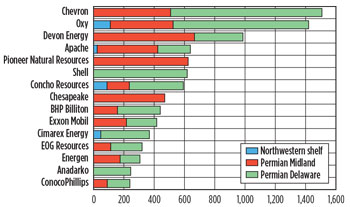 |
| Fig. 1. Top net acreage-holders in the Permian, differentiated by basin, in terms of thousands of acres (source: NAS Report, Permian Tight Oil). |
|
FROM VERTICAL TO HORIZONTAL WELLS
The Permian basin has experienced a significant increase in activity over the last year. Since the start of 2013, the horizontal rig count has increased 63 rigs in the Delaware, and 90 in the Midland, bringing the total number of horizontal rigs to 166 and 136, respectively. In terms of active rigs, the Delaware and Midland basins, combined, have now surpassed the Eagle Ford and Bakken shales, which had 210, and 179 rigs, respectively as of the end of second-quarter 2014. Pioneer, Concho, Apache and Oxy have been the companies that have contributed the most to the growth. In terms of drilling contractors, H&P has increased its rig count the most, going from 15 at the beginning of 2013 to 57 at the end of May 2014. Most of the additional rigs have been new-builds.
In the early years of development, companies were primarily drilling vertical wells, targeting a combination of the Spraberry and Wolfcamp formations in the Midland basin, often called Wolfberry. Starting in 2010/2011, companies began to drill horizontal wells into the Bone Spring and Avalon formations in the Delaware basin, and horizontal wells into the Spraberry, in the Midland basin, Fig. 2. Due to the higher potential liquid content of the Wolfcamp, companies tend to prioritize this formation over the Spraberry; Wolfcamp activity began to significantly increase during 2013. By 2015, we, at Rystad Energy, estimate that the Wolfcamp will pass the Wolfberry in terms of number of yearly wells targeting the formation.
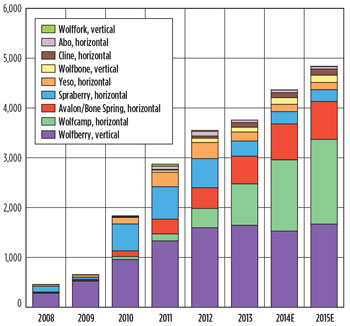 |
| Fig. 2. Number of Permian basin unconventional (multi-stage fraced) wells, ranked by targeted formation (source: NASCube). |
|
Another important driver for the increased well count is drilling efficiency. Compared to 2011, operators in Midland have on average reduced the drilling time by almost 20%. In Delaware the same efficiency gains have been around 13%. One of the key reasons for the improved drilling time has been the introduction of pad drilling. Currently, about 55% of the wells in Midland are drilled from pads, while Delaware numbers are just below 30%. By increasing pad drilling, efficiency could be even higher, which would lead to additional wells and lower cost per well.
DELAWARE ONE STEP AHEAD OF MIDLAND
As the Permian’s horizontal activity picks up, it is important to follow the well performance. Well results vary between different parts of the play and many companies are still in the progress of drilling appraisal wells. Official well data give a unique insight into how the wells perform. Figures 3 and 4 show the 30-day average initial production (IP) and light oil content for wells drilled in the Wolfcamp (Midland and Delaware), Bone Spring (Delaware) and Spraberry (Midland) formations.
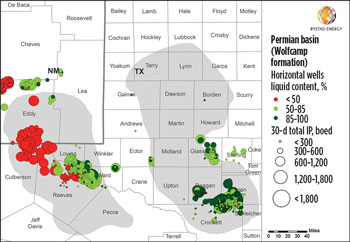 |
| Fig. 3. 30-day average IP and light oil content for horizontal wells drilled in Wolfcamp (source: NASWellData). |
|
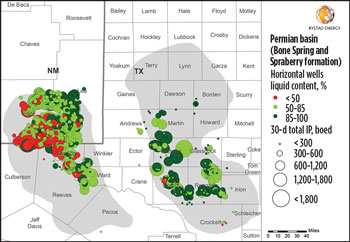 |
| Fig. 4. Average 30-day average IP and light oil content for horizontal wells drilled in Bone Spring and Spraberry (source: NASWellData). |
|
Activity in the Wolfcamp portion of the Delaware has been sparse in New Mexico, with most of the wells drilled close to the Texas border. Moving south, into Texas, the wells drilled in Culberson County, and the northern part of Reeves County, have light oil content below 50%. At the same time, this area has the wells with the highest IP, due to the initial push from the gas. Moving farther southeast, Ward is the key county in the Delaware. Here, we see some of the best Wolfcamp wells, with an average 30-day IP of 670 boed and light oil content of ~80%. Cimarex, Anadarko and Shell are well-positioned in the area and have drilled the most wells.
In the Midland basin, Glasscock is the northernmost county that has Wolfcamp activity. There, the 30-day average IP is ~400 boed, and light oil content is ~70%. The southern part of the Midland basin is where the main Wolfcamp activity has been focused, principally in Crockett, Reagan and Irion counties. In these counties, EOG, EP Energy, Devon and Apache have been the most active operators. Comparing these counties, Irion has experienced the highest, average 30-day IP, at ~450 boed, compared to the two other counties, where the IP is ~300 boed. In the central part of the basin, Pioneer is targeting the Wolfcamp in Midland and Martin counties. Early well results indicate IPs as high as 1,000 boed, with an oil content of ~80%.
Looking at development work in the Bone Spring formation (Delaware basin), the trend is opposite of the Wolfcamp. Most activity takes place in New Mexico, particularly in Eddy and Lea counties. For both counties, the 30-day average IP is ~600 boed. According to Fig. 4, the light oil content is higher in Lea County. In Eddy County, Devon and Concho have been the most active companies, and in Lea County, EOG, Cimarex, Devon and Concho have drilled most of the wells. Across the border, Loving County has been the Texas county with the most Bone Spring wells, and Energen and Anadarko have been the most active companies. The well results in Loving have been very similar to those in Eddy County.
In the Midland basin, the Bone Spring formation is not present. Instead, companies are most actively targeting the Spraberry formation. Both the Bone Spring and Spraberry are shallower than the Wolfcamp, and are also targeted with horizontal wells. The two key Spraberry counties are Upton and Reagan, where Pioneer is the main operator. While most of the wells have been drilled in Reagan County, wells in Upton County have seen better IPs and higher light oil content, compared to Regan. Here the 30-day average IP has been ~650 boed (80% oil), vs. 500 boed (70%).
The differing well results, in terms of IP, are summarized in Fig. 5. This chart indicates that the historical wells in the Delaware basin have outperformed the wells in the Midland basin. The wells in the Wolfcamp formation of the Delaware have had the highest IPs, with an average of ~610 boed. IP rates have also increased systematically across all areas during the last three years. The IP rate in the Spraberry formation has tripled over the last three years, and the wells in the Bone Spring have increased their IPs by 20% over the same period.
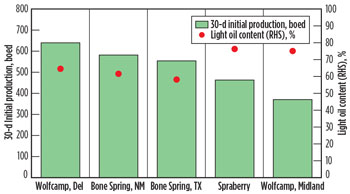 |
| Fig. 5. Average 30-day IP and light oil content for different formations in the Permian, based on all horizontal wells drilled between 2011 and 2013 (source: NASWellData). |
|
PLAY BENCHMARKING: PERMIAN STILL TRAILS
When benchmarking the Permian against other U.S. shale plays, the natural peer group is the Eagle Ford (Texas), Bakken (North Dakota) and Niobrara (Colorado/Wyoming), and the natural benchmarks are IP, EUR, well costs and break-even prices.
Starting with IPs, Fig. 6 shows the average 30-day initial production for all the horizontal wells drilled into different plays between 2011 and 2013. Historically, the Eagle Ford has reported the highest IPs, at about 730,000 boed (60% light oil). The Bakken’s wells have had the highest liquid content, with IPs slightly lower than in the Eagle Ford. The Permian Delaware can compete with the Eagle Ford’s light oil content, but in terms of total IPs, the Delaware is 25% lower than the Eagle Ford. The average early well performances for the Midland basin are comparable with the Niobrara, with IPs ~400 boed.
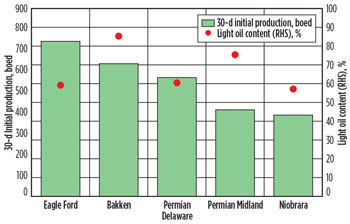 |
| Fig. 6. Average 30-day IP and light oil content for different shale plays, based on all horizontal wells drilled between 2011 and 2013 (source: NASWellData). |
|
The same conclusions can be drawn from Fig. 7. This chart shows the average cumulative production for all the wells drilled between 2011 and 2013, as a function of cumulative monthly production. The comparison includes production for the first three years and is a good indicator of the EUR. Again, the Eagle Ford and Bakken are performing better than the Permian. The Permian Midland has the least cumulative production at the end of three years. At the same time, it’s important to stress that the Permian basin is having strong year-on-year learning. Continuously better well results may close the gap between the Permian and other liquids plays.
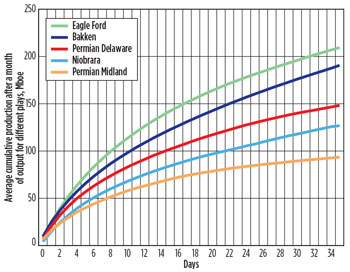 |
| Fig. 7. Average cumulative production after a month of output for different plays, thousand boe (source: NASWellData). |
|
To determine the profitability of wells, the cost for drilling and completion is another key parameter to consider. The most expensive play is the Bakken, with an average well cost of ~$10 million, followed by the Eagle Ford at ~$9 million, horizontal Delaware wells at ~$7.2 million and Midland holes at ~$7 million. Niobrara wells are the least expensive, with an average well cost of ~$5.5 million.
The break-even price can be estimated for each well and play by considering the average IP, EUR, liquid content and well cost. The Eagle Ford has the lowest average break-even price of $45/bbl, followed by the Bakken at $50/bbl. The Delaware and Niobrara have almost the same price at $55/bbl, while the Midland follows at $60/bbl.
PERMIAN’S EDGE: LOCATION, LOCATION, LOCATION
A key parameter for determining potential growth is drilling location. In that respect, the Permian stands out, compared to other plays. The multi-stacked and thick formations provide a large number of potential drilling locations. The number of horizontal un-risked drilling locations in the Permian is estimated at ~170,000, and vertical locations are thought to be ~130,000. As a comparison, the Eagle Ford holds ~90,000 locations, while the Bakken only has ~65,000. The majority of drilling locations are expected to generate high activity growth going forward, and by 2018, the yearly well count could reach as many as 6,000 wells, equal to almost 50% growth compared to the wells expected to be drilled this year.
If well results continue to improve, and companies continue to ramp up activity as expected, Rystad Energy estimates that by 2020, the Permian’s combined production will surpass the Eagle Ford and be the play with the greatest light oil production, at an annual average of 2.2 MMbpd. At the same time, investment in the play is expected to double over the next five years. When one realizes this, it is not difficult to understand why the Permian is the current play-of-choice for both E&P and oil field service companies. 
NOTE
Rystad Energy is an independent oil and gas consulting services and business intelligence data firm, offering global databases, strategy consulting and research products. Rystad Energy’s headquarters are in Oslo, Norway. Further presence has been established in the UK (London), U.S. (New York and Houston), Russia (Moscow), Africa and Southeast Asia.
|










